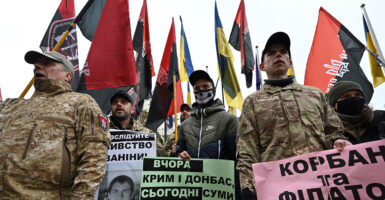Last week, the United States, NATO, and Russia met to discuss the worsening situation regarding U.S. ally Ukraine, with Russia stationing more than 100,000 troops on Ukraine’s border and recently sending thousands more troops into Belarus, its military ally, just to the north of Ukraine.
The meetings unfortunately yielded little fruit.
The U.S. raised issues at the bilateral Strategic Stability Dialogue such as missile placement, military exercises, and arms control, but Russia’s continuing aggression against Ukraine was the thorniest issue at the table.
The U.S. urged Russia to de-escalate the situation along the border, but Russia continued to claim that it has no intentions of attacking or further invading Ukraine, and said the West should not fear “any kind of escalation.”
Of course, this was likely a bluff on Russia’s part, considering that the White House said this week that Russia could launch an attack on Ukraine “at any point.”
Russia has been building up its troops for months, since April of last year, in fact; but now the pressure is building because Russia is demanding more and more from the West, and its demands have not been met.
Russia is demanding security guarantees such as NATO retracting its offer of membership to Ukraine and the cessation of all United States and allied military activity in Eastern Europe and Central Asia.
If Russia should choose to further invade Ukraine, the U.S. has made it clear that there will be significant consequences for Moscow “well beyond” what it faced in 2014.
So far, it appears that these “significant consequences” could mean severe economic sanctions, but these might not be sufficient given that Moscow has learned to evade sanctions over the years. In 2014, the U.S. imposed sanctions on Russian individuals and entities and utilized diplomacy rather than military force in response to Russia’s takeover of Crimea.
The U.S. also made it clear to Russia that it will “not allow any nation to slam closed NATO’s ‘Open Door’ Policy,’” a policy where NATO membership remains open to other European countries, including Ukraine.
Following the Strategic Stability Dialogue meeting, the NATO-Russia Council met.
In the talks, NATO allies insisted that Russia “respect the sovereignty and territorial integrity of its neighbors.” The alliance also reaffirmed it would not accept Russian demands to uninvite Ukraine into the NATO alliance.
NATO offered Russia a series of further meetings to discuss wider issues such as arms control and Russian intermediate-range nuclear missile deployments in Europe, but the Russian delegation demurred, likely awaiting President Vladimir Putin’s orders for to what to do next.
Following the meeting, NATO Secretary-General Jens Stoltenberg reported that “significant differences remained” between NATO and Russia.
The following day, the Organization for Security and Cooperation in Europe met. Unlike at the previous meetings, Ukraine was finally present at the negotiating table because it is an organization member.
Nevertheless, the talks ended in a deadlock. Neither the Russian side nor the Western side would budge on its core positions regarding Ukraine.
None of these meetings were extremely fruitful. Diplomacy seems to be the main strategy of the Biden administration’s foreign policy, at least regarding the threat Russia poses. While diplomacy is inherently good, it might not be the best primary strategy in this situation regarding Ukraine.
Instead, the U.S. could employ better strategies that exhibit more strength, such as continuing to give Ukraine financial military aid, selling the country more weaponry with which to defend itself, providing military training to its soldiers, sharing intelligence of the Russian military buildup, and killing off the Nord Stream 2 pipeline.
From Russia’s perspective, these talks simply served as a means to buy time to decide what it will do in the coming weeks—such as whether to further invade Ukraine, and an opportunity to come up with excuses for doing so.
One excuse—actually a fabrication—on Moscow’s part is that Ukraine is the one provoking tensions, not Russia. But it is a fact that Russia invaded and continues to occupy Ukraine’s Crimean Peninsula, continues to stoke a war in Ukraine’s eastern Donbas region that has claimed nearly 14,000 lives, and now unnecessarily has more than 100,000 troops stationed along Ukraine’s border.
Ukraine is not the one threatening to invade Russia, and neither are the U.S. or NATO.
Ukraine has the right to self-defense, and the U.S. needs to help it along this path. One way the U.S. has done this just this week is by providing the nation with an additional $200 million in defensive military aid.
U.S. Secretary of State Antony Blinken met with Ukrainian President Volodymr Zelenskyy and Foreign Minister Dmytro Kuleba in Kyiv today and reiterated to them that the U.S. and its allies are steadfast in backing Ukraine and “its democratic aspirations” despite a potentially imminent Russian attack.
Putin is trying to take advantage of President Joe Biden throughout this situation, especially because Biden appears weak following his failed withdrawal from Afghanistan.
Both the U.S. and NATO said they will negotiate with Russia on Ukraine if Russia de-escalates the situation and withdraws its more than 100,000 troops from the border. But whatever happens, the U.S. should not make any concessions to Russia. That will be something to watch for in the upcoming meeting between Blinken and Russian Foreign Minister Sergei Lavrov in Geneva this Friday.
The West must stand firm against Russia as it attempts to up-end the international world order.
Have an opinion about this article? To sound off, please email letters@DailySignal.com and we’ll consider publishing your edited remarks in our regular “We Hear You” feature. Remember to include the URL or headline of the article plus your name and town and/or state.

























